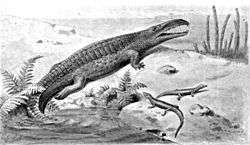1842 in paleontology
Paleontology or palaeontology is the study of prehistoric life forms on Earth through the examination of plant and animal fossils.[1] This includes the study of body fossils, tracks (ichnites), burrows, cast-off parts, fossilised feces (coprolites), palynomorphs and chemical residues. Because humans have encountered fossils for millennia, paleontology has a long history both before and after becoming formalized as a science. This article records significant discoveries and events related to paleontology that occurred or were published in the year 1842.
| |||
|---|---|---|---|
|
Dinosaurs
Newly named dinosaurs
|
| ||||||||||||||||||
gollark: Hey, that could be fun, I should try that.
gollark: BRB, uploading passwords and SSH keys to internet.
gollark: I would, but I don't have pro.
gollark: I guess 76 people are scraping all or a significant subset of pastes?
gollark: You want the keycode associated with a character?
See also
References
- Gini-Newman, Garfield; Graham, Elizabeth (2001). Echoes from the past: world history to the 16th century. Toronto: McGraw-Hill Ryerson Ltd. ISBN 9780070887398. OCLC 46769716.
- Meyer, H. von. 1842. Notes on labyrinthodonts and fossil reptiles, including a description of Belodon plieningeri, new gen. and sp. Neues Jahrbuch fur Mineralogie, Geologie und Palaontologie 1842, pp. 301-304.
This article is issued from Wikipedia. The text is licensed under Creative Commons - Attribution - Sharealike. Additional terms may apply for the media files.
